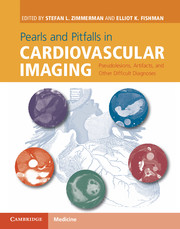 Pearls and Pitfalls in Cardiovascular Imaging
Pearls and Pitfalls in Cardiovascular Imaging from Section 1 - Cardiac pseudotumors and other challenging diagnoses
Published online by Cambridge University Press: 05 June 2015
Imaging description
Valvular masses can be challenging when encountered on cardiac CT or MRI. Echocardiography is the test of choice for evaluation of the valves; however, in some patients, CT or MRI may be requested due to lack of adequate imaging windows or need to evaluate for associated complications. Vegetations in the setting of infective endocarditis are more common than valvular tumors, are mobile during the cardiac cycle, low attenuation on CT (Figure 8.1), and low signal intensity on T1- and T2-weighted MRI. They are associated with valvular thickening or other sequelae of infectious endocarditis such as valvular regurgitation, perforation (Figure 8.1), fistulas between cardiac chambers, paravalvular abscesses, and pseudoaneurysms. Primary tumors of the valve are rare. Of these, the most commonly encountered valvular tumor is a papillary fibroelastoma which is commonly round with an irregular, frond-like surface. It will be low in attenuation on CT images (Figure 8.2), similar to the valve tissue, and will have intermediate T1 and high T2 signal intensity on MRI with homogenous delayed enhancement (Figure 8.3). Papillary fibroelastomas are usually mobile on a stalk, moving with the valve leaflets through the cardiac cycle. Involvement of the aortic and mitral valve is more common than the tricuspid and pulmonic valve.
Importance
Although rare, valvular masses are important to recognize at cardiac imaging due to the fact that they pose a risk of distal embolization. In patients with infective endocarditis, neurologic complications develop in 20–40%. Although benign, the treatment of choice for valvular tumors is surgical resection to avoid these complications. Antibiotic therapy may be used to treat vegetations; however, in complicated cases, such as those with fistulas or abscesses, surgical valve replacement may be necessary.
Typical clinical scenario
Valvular masses may be encountered incidentally or may be referred to advanced imaging after discovery at echocardiography. Coronary CT angiography may be used to preoperatively evaluate the coronary arteries in patients who are planned for valve replacement.
To save this book to your Kindle, first ensure [email protected] is added to your Approved Personal Document E-mail List under your Personal Document Settings on the Manage Your Content and Devices page of your Amazon account. Then enter the ‘name’ part of your Kindle email address below. Find out more about saving to your Kindle.
Note you can select to save to either the @free.kindle.com or @kindle.com variations. ‘@free.kindle.com’ emails are free but can only be saved to your device when it is connected to wi-fi. ‘@kindle.com’ emails can be delivered even when you are not connected to wi-fi, but note that service fees apply.
Find out more about the Kindle Personal Document Service.
To save content items to your account, please confirm that you agree to abide by our usage policies. If this is the first time you use this feature, you will be asked to authorise Cambridge Core to connect with your account. Find out more about saving content to Dropbox.
To save content items to your account, please confirm that you agree to abide by our usage policies. If this is the first time you use this feature, you will be asked to authorise Cambridge Core to connect with your account. Find out more about saving content to Google Drive.